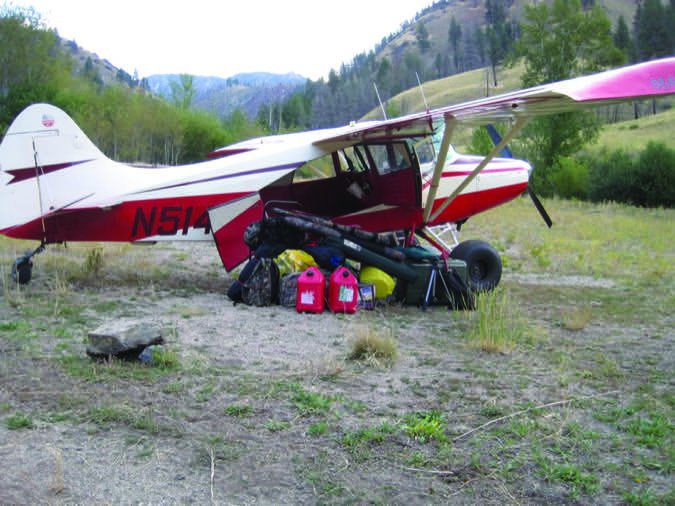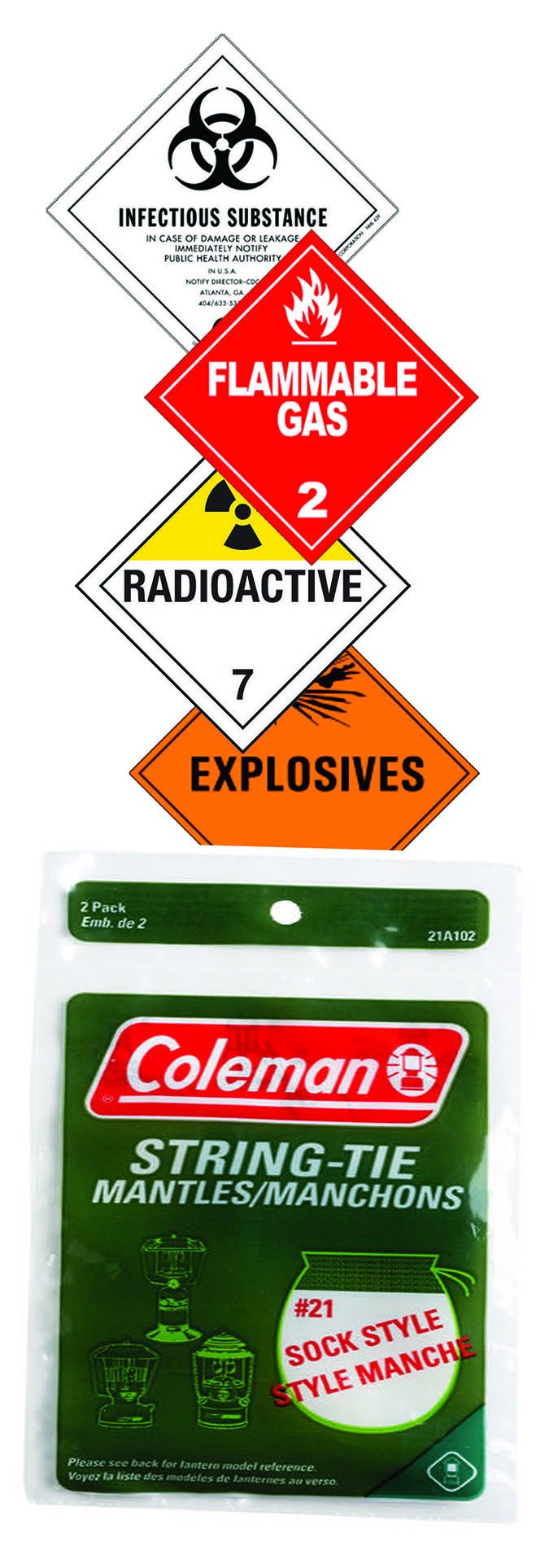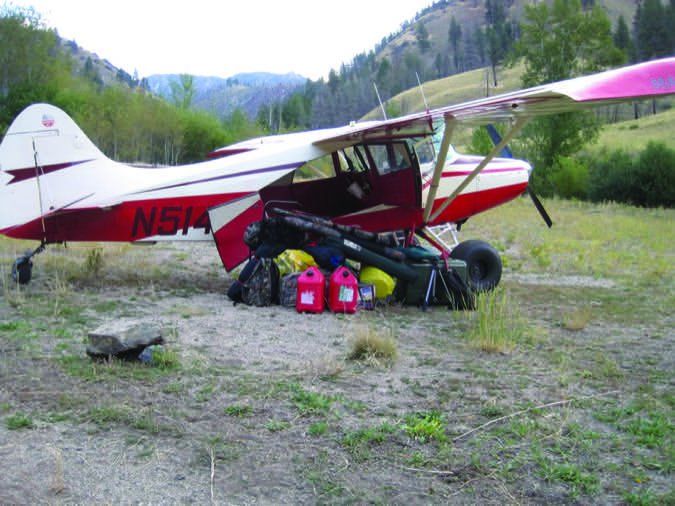
Out flying about here in Idaho, it’s amazing the kind of useful cargo that gets thrown into a typical personal airplane. Personally, I’ve flown white gas, propane, butane, isobutene, bear spray, flares, magnesium metal, petroleum jelly-soaked cotton, windproof matches, fire starter, resin wood, radioactive materials, guns and ammunition. And that’s just my emergency kit. I also usually carry (mostly) full tanks of aviation fuel and an engine filled with oil. You probably do, also.
All of this stuff is considered hazardous material, and there is an abundant, detailed set of rules, regulations and training required if you are going to carry this stuff for hire under FAR Parts 121 and/or 135. I am not a lawyer, so don’t consult me for legal advice, but Part 91 pilots can wrap a box of lithium-ion batteries in 100LL-soaked shop towels, throw it all in the back seat and go aviate without worrying about break a reg. Just because you can, of course, doesn’t mean you should.
The Obvious Culprits
As I alluded to, the obvious potential hazardous materials are things we have in our emergency kits. I don’t smoke, but when I fly, I like to have a lighter on my person just in case. I also usually have a knife that can be used for cutting away seatbelts. The knife is not a hazardous material, the matches and lighter, however, are. Likewise, when I fly into the backcountry, my safety vest is fully equipped with bear spray, firestarters, weatherproof matches and, occasionally, a small isobutyl microstove.
Not only do I have these hazardous materials in my plane, I try to carry the stuff on my person. For those pilots who fly planes with ballistic parachutes, you are obviously packing explosives on board. And of course, the fossil fuel in our wings is perhaps the single most hazardous things we carry. I don’t say that in jest. When atomized, the energy in one gallon of gasoline has four times the explosive power of TNT.
Think about it: Ten gallons of 100LL is capable of launching a 3000-pound plane thousands of feet into the air, or moving it more than 100 miles distant. A wise pilot directs all that energy with sound engine and airspeed management, but it isn’t the pilot’s will that makes the thing fly; it’s the controlled explosions inside the pistons.
Firearms
When I go hunting out of backcountry airstrips in Idaho, I have multiple guns and ammunition on board. By Part 121 and 135 rules, I would need to keep the guns in a separate locked hard case and the ammo in containers designated for carrying ammo. Under commercial operations, guns and ammo must be kept separated unless the passenger was an authorized person (such as a federal air marshal) with documented credentials.
Under Part 91, unless you ask, you don’t really know if your passengers are packing heat. I realized this at a meeting of the Idaho Aviation Board meeting held at the Sulfur Creek Lodge. The topic of concealed carry came up and the next thing I knew, two people were comparing their respective sidearms. To my surprise, this included my passenger. He didn’t have to disclose that he had a weapon and, until that point in my flying career, it had never occurred to me to ask.
Novel Cargo

On September 15, 2009, a Cessna 208 Caravan operating as a Part 135 on-demand air taxi suffered an engine failure and was force-landed in Sheffield, Mass. None of the six aboard were injured.
One of the passengers was an explosives specialist. He reported to first responders that the airplane contained a binary explosive: “individual containers of ammonium nitrate and nitromethane.” Additionally, electric detonators were stored in a metal box mounted to the airplane’s aft cabin floor.
The binary explosive containers were completely consumed in the post-crash fire, while the metal box with the detonators was found mostly intact, although its padlock had been burned off. Some of the detonators were determined to be unstable and were transported to a sand bunker where they were detonated.
Meanwhile, on December 17, 2007, the crew of a Beech 1900 carrying a cargo of compressed gas cylinders with screw type valves and a threaded metal safety cap to protect the valves aborted a takeoff and taxied back to the airport ramp after hearing a “hissing” sound from the cargo area.
Once on the ramp, the captain shut off the engines, but the flight crew lost consciousness before they could exit the airplane. A freight agent noticed the airplane sitting on the ramp and found the first officer unconscious, in the cabin, with the captain unconscious at the controls. The flight crew regained consciousness while lying on the ramp but were hospitalized overnight.
The NTSB’s probable cause statement in this incident found the flight crew failed to properly load and secure the cylinders, leading to their incapacitation. Contributing were improper procedures used by the shipper and the operator’s failure to properly train the flight crew.
More Novel Cargo
Pilots have been known to carry lawn mowers (which have been known to catch fire on board), LP tanks, barbecue grills, spare gasoline cans, white gas, herbicides, pesticides, fireworks and assorted odds and ends that would require a hazardous material placard if carried under Part 121 or 135, if they weren’t completely barred from passenger aircraft in the first place.
The wise pilot should give a great deal of thought about the hazards of the chemicals, particularly those that are forbidden aboard passenger flights. That said, materials that are barred from cargo operations should leave you doubly concerned.
Don’t Be That Guy
If you think or know your cargo might be hazardous, do the right thing. You are pilot in command and what happens on your flight is your responsibility. If there is an explosive on board (fireworks, ammunition, a ballistic parachute charge) maybe you should know how to handle it safely both as cargo—when loading or unloading it—or in the event of an accident.
If there is a compressed gas cylinder, maybe you should know what is in it, whether the container is airworthy and what the gas might do if it was released. (This also applies to a portable oxygen bottle we might use at altitude—is the thing adequately secured?) Flammable liquids? How much? What kind of containers? Is it near an ignition source like a Janitrol heater installed in the nose of many piston twins?
Even though Part 91 operators are not subject to the many hazardous-materials rules affecting commercial operators, it’s easy to become complacent about what you carry in your airplane. Do yourself and your passengers a great big favor: Don’t.
Radioactive Cargo
You may not realize it, but a white gas lantern mantle releases gamma radiation due to the radioactive daughter products of thorium. A 1981 study conducted at Oak Ridge National Laboratory calculated that the use of lantern-mantles every other weekend for a year results in a radiation dose of 0.3 to 0.6 millirems. On average, Americans receive a radiationdoseof about 620millirem each year. Obviously, this is a minute amount of radiation, but if a buddy asked if you could bring him a case of lantern mantles for his fishing lodge when you come up to visit, you might actually have a hotter load than you realized.
Look It Up
It makes a lot more sense if you understand the rules or have some training, but pilots who can decipher the FARs should be capable of looking up hazardous materials that are regulated for commercial carriers. This information is available online in the U.S. Department of Transportation’s Hazardous Materials Table, a large document listing the material, its hazmat classification and other critical information.
The hazmat rules are as complex as the FARs. But if you are thinking about hauling some TNT, fireworks, white phosphorous flares or some other novel (and perhaps dangerous) cargo, you might want to understand how the pros are expected to deal with the particular material you are handling before dumping it into your airplane’s back seat. Substantial portions of these regulations are about marking, notification and paperwork, but there are other insights into why the material is considered a hazard, compatibility with other materials, packaging requirements and whether they are allowed on cargo or passenger flights.
Mike Hart is an Idaho-based flight instructor and proud owner of a 1946 Piper J-3 Cub and a Cessna 180. He also is the Idaho liaison to the Recreational Aviation Foundation.





I really don’t remember giving permission to use a picture of my airplane in your article. A little background on myself, I’m a retired Army Blackhawk pilot, retired FAA Principal Operations Inspector General Aviation, and currently employed as an industrial helicopter pilot. Anyway I read your article. You stated that you wear bear spray attached to your person while flying. That is the most dangerous and ill-conceived procedure I’ve heard of all year. Hobbie pilots never cease to amaze me. Good day.